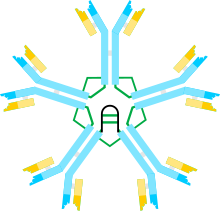Isolated primary immunoglobulin M deficiency
| Isolated primary immunoglobulin M deficiency | |
|---|---|
| Other names | Selective IgM immunodeficiency |
 | |
| Immunoglobulin M | |
| Specialty | Hematology |
Isolated primary immunoglobulin M deficiency
The cause of selective IgM deficiency remains unclear, although various mechanisms have been proposed, such as an increase in regulatory T cell functions, defective T helper cell functions and impaired terminal differentiation of B lymphocytes into IgM-secreting cells among others.[2] In addition it was recently described that hypomorphic mutations in the B-cell receptor (BLNK & BTK) lead to selective IgM deficiency.[4]
It is however puzzling that class switching seems to happen normally (serum levels of other antibodies are normal), while dysfunctioning of IgM synthesis is expected to occur together with abnormalities in other immunoglobulins. Notwithstanding a clear pathogenesis and commonly accepted definition, a cutoff for SIgMD could be the lower limit of the serum IgM reference range, such as 43 mg/dL[5] in adults or even 20 mg/dL.[6]
Signs and symptoms
Patients diagnosed with isolated primary immunoglobulin M deficiency frequently exhibit recurrent infections with common microorganisms as well as a higher incidence of autoimmune and allergy disorders. More than 80% of patients with isolated primary immunoglobulin M deficiency have recurrent infections as their presenting symptom. Serious, potentially fatal illnesses could arise from several of these bacterial diseases. Isolated primary immunoglobulin M deficiency can manifest clinically as recurrent otitis media, bronchiectasis, chronic sinusitis, bronchitis, urinary tract infections, respiratory infections, cellulitis, meningitis, and sepsis.[7]
See also
- Immunodeficiency with hyper-immunoglobulin M
- Immunoglobulin M
- List of cutaneous conditions
References
- ISBN 978-1-4160-2999-1.
- ^ S2CID 23098220.
- PMID 17201230.
- PMID 30619340.
- ^ UC Davis Medical Center. "Revised reference range IgM" (PDF). Retrieved 30 December 2011.
- ^ The Merck Manual of Diagnosis and Therapy. Merck Sharp & Dohme Corp. 2004. pp. Appendix II.
- PMC 5591887.
